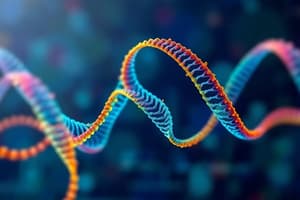Podcast
Questions and Answers
Which measure is commonly used to describe the typical values in a dataset?
Which measure is commonly used to describe the typical values in a dataset?
- Variance
- Interquartile range
- Mean (correct)
- Standard deviation
What can occur if the assumptions of a statistical test are violated?
What can occur if the assumptions of a statistical test are violated?
- Statistical significance will be guaranteed.
- The results will always be correct.
- The computational time will decrease.
- The validity of the results may be compromised. (correct)
Which statistical method is used to model the relationship between a dependent variable and one or more independent variables?
Which statistical method is used to model the relationship between a dependent variable and one or more independent variables?
- Dispersion analysis
- Hypothesis testing
- Regression (correct)
- Correlation
In statistical analyses, what does the measure of dispersion indicate?
In statistical analyses, what does the measure of dispersion indicate?
Why is it important to interpret statistical results in the context of biological knowledge?
Why is it important to interpret statistical results in the context of biological knowledge?
What is the role of statistical significance in bioinformatics?
What is the role of statistical significance in bioinformatics?
Which distribution would be appropriate for modeling count data in bioinformatics?
Which distribution would be appropriate for modeling count data in bioinformatics?
What does a low p-value indicate in hypothesis testing?
What does a low p-value indicate in hypothesis testing?
Which of the following concepts relates to drawing conclusions from sample data?
Which of the following concepts relates to drawing conclusions from sample data?
What does Type II error refer to in statistical hypothesis testing?
What does Type II error refer to in statistical hypothesis testing?
In genomic data analysis, which statistical technique is commonly used for genome-wide association studies (GWAS)?
In genomic data analysis, which statistical technique is commonly used for genome-wide association studies (GWAS)?
What is a confidence interval used for in statistical analysis?
What is a confidence interval used for in statistical analysis?
Which statistical method is used to assess differences in gene expression levels?
Which statistical method is used to assess differences in gene expression levels?
Flashcards
Central Tendency
Central Tendency
Describes the typical values in a dataset, using measures like mean, median, or mode.
Statistical Tests Assumptions
Statistical Tests Assumptions
Statistical tests often require specific data properties (e.g., data is normally distributed).
Correlation
Correlation
Measures the relationship between two variables. Positive or negative.
Hypothesis Testing
Hypothesis Testing
Signup and view all the flashcards
Distribution Modeling
Distribution Modeling
Signup and view all the flashcards
Bioinformatics uses stats
Bioinformatics uses stats
Signup and view all the flashcards
Statistical Significance in Bio
Statistical Significance in Bio
Signup and view all the flashcards
Probability Distributions
Probability Distributions
Signup and view all the flashcards
Hypothesis Testing Purpose
Hypothesis Testing Purpose
Signup and view all the flashcards
Type I Error
Type I Error
Signup and view all the flashcards
Confidence Interval
Confidence Interval
Signup and view all the flashcards
Sample Size's Importance
Sample Size's Importance
Signup and view all the flashcards
Statistical Analysis in Sequencing Data
Statistical Analysis in Sequencing Data
Signup and view all the flashcards
Study Notes
Bioinformatics Statistics
- Bioinformatics uses statistical methods to analyze biological data like DNA sequences, gene expression, and protein structures.
- Statistical methods extract meaningful information from complex biological datasets.
- Common techniques include hypothesis testing, regression, correlation, and clustering.
- Statistical significance is vital to determine if patterns are real or random.
Statistical Theory in Bioinformatics
- Statistical theory provides the mathematical framework for biological data analysis.
- Probability distributions (normal, binomial, Poisson) are foundational.
- Statistical inference draws conclusions about a population from a sample.
- Hypothesis testing evaluates if observed differences are statistically significant.
- P-values quantify evidence against a null hypothesis; low p-values suggest strong evidence against the null.
Data Types and Statistical Analysis
- DNA and RNA Sequencing: Statistical methods assess gene expression differences, identify mutations, and align sequences. Techniques include chi-squared tests and Poisson regression.
- Microarray Data: Statistical analyses identify differentially expressed genes using t-tests and ANOVA.
- Protein Structure Prediction: Statistical models, often using machine learning, predict protein structure from amino acid sequences.
- Genomic Data: Statistical analysis in genome-wide association studies (GWAS) identifies genes linked to traits using logistic regression and linear models.
Statistical Significance and Error
- Statistical significance ensures reliability, avoiding random chance results.
- Type I error (false positive) and Type II error (false negative) are critical in hypothesis testing.
- Confidence intervals provide a range of plausible values for a population parameter.
- Larger sample sizes generally lead to increased statistical power.
Tools and Software
- R and Python are common bioinformatics analysis tools.
- These programs offer statistical tests, data visualization, and modeling capabilities.
- Specialized bioinformatics packages and libraries in R and Python (e.g., Bioconductor) support complex biological data analysis.
Assumptions & Limitations
- Statistical tests often rely on data assumptions (e.g., normality, independence).
- Choosing the right statistical test is crucial for accurate conclusions.
- Results should be interpreted considering biological knowledge and experimental design.
- Large datasets can present computational challenges.
Applications
- Gene expression analysis under various conditions.
- Identifying disease-associated genes.
- Predicting protein structure and function.
- Developing disease treatments.
- Understanding species evolution.
- Examining ecological patterns.
Key Concepts
- Central tendency: Mean, median, mode describe typical data values.
- Dispersion: Standard deviation, variance, interquartile range show data spread.
- Correlation: Measures association between two variables.
- Regression: Models the relationship between dependent and independent variables.
- Hypothesis testing: Evaluates statistical significance.
- Probability: Quantifies event likelihood in biological systems.
- Distribution modeling: Models biological data to understand its distributions.
Studying That Suits You
Use AI to generate personalized quizzes and flashcards to suit your learning preferences.




